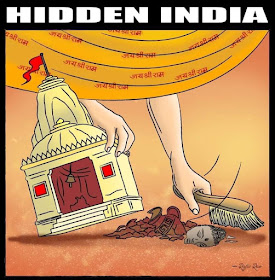When Alexander the Great liberated the West Indies from the Persians, the Indians had no connection with the ancient culture of the Indus Valley. Moreover, the liberated Indians of the East had no intention of liberating the West Indies.
When Megasthenes went to India in 302 BCE , he saw a society where reading and writing skills were almost unknown. The buildings were made of wood,since Indians did not know how to process stone.The reason why not one single piece of monumental architecture has survived from ancient India, is simply because the natives didn't have the knowledge or the ability to build one. It was the Greeks who taught Indians stone sculpture and architecture. Metalworking techniques, such as the lost-wax method for making statues ,were adopted at a much later date.
Indian Sculpture: The Aniconic Years Before the Greeks
Early Indian art, including the Mauryan and post-Mauryan art, has been heavily influenced by Greek and Persian influences. Mathura and Gandhara served as a conduit for the transfer of Greco-Persian artistic styles.
Writing and Language
During the time of Megasthenes, Indians did not know how to write. It was the Greeks who taught them how to write, by adopting the Aramaic script used by the Persians and using it to make Kharosthi and Brahmi. Karoshthi died out, but Brahmi spread far and wide to South East Asia. The Hellenized Kingdoms that were established in India after the Indo-Greeks, -like the Scythians, Parthians, Kushanas, Alchon, Huns,et.c.- used Greek as their official language, along with Prakrit, even though they were of Iranian stock.
Sciences
There is little doubt that the Greeks were far more advanced than Indians in the field of Sciences. India didn't really have an independent scientific tradition until about the middle of the 1st millennium CE. From the period of 300BCE to 300 CE, people were busy ‘Indianizing’ Greek works on mathematics, astronomy and astrology.As far as architecture is concerned, the buildings and infrastructures at Taxila and Sircap were modelled on Greek cities. Ujjain became an intellectual centre under the rule of Scythians, who were avowedly following Greek culture.
Medicine
Muslim invaders reintroduced to India what is known as Unani medicine. This type of Medicine originated in in Greece, it was carried to India through the Greeks, and returned under the Muslim rulers, who had also embraced it as their own.
Coinage in India: Also influenced by the Greeks
The Indians did not have their own coins.Instead, they used punchmarked coins of Persian origin until the Greek kingdoms made the first Indian coins; some of them depicted Hindu deities.Moreover, Greek characters were used in the coins of Gupta Kings as late as the 5th century CE.
Greek influence on Buddhism
Below, there are some articles from the blog's Archives related to the Greek influence in India.
THE IMPORTANCE OF THE GREEK PRESENCE IN INDIA
https://greekasia.blogspot.com/2019/06/the-importance-of-greek-presence-in.html
GREEK INFLUENCES ON INDIAN CULTURE
https://greekasia.blogspot.com/2019/06/greek-influences-on-indian-culture.html
GREEK INFLUENCE ON INDIAN ASTRONOMY AND ASTROLOGY
https://greekasia.blogspot.com/2019/07/greek-influence-on-indian-astronomy-and.html
YAVANEŚVARA ~ THE TRANSMISSION OF GREEK ASTROLOGICAL SCIENCE INTO INDIA https://greekasia.blogspot.com/2019/07/yavanesvara-transmission-of-greek.html
GREEK EDICT OF ASHOKA
https://greekasia.blogspot.com/2019/06/greek-edict-of-ashoka.html
INDO GREEK COINS - THE FIRST LANDMARK IN INDIA
https://greekasia.blogspot.com/2019/06/indo-greek-coins-first-landmark-in-india.html
FIRST VISUAL REPRESENTATIONS OF INDIAN DEITIES BY GREEK KING AGATHOCLES
https://greekasia.blogspot.com/2019/06/first-visual-representations-of-indian.html
ANTHEMION ~ GREEK DECORATIONS IN INDIA
https://greekasia.blogspot.com/2019/06/flame-palmettes-greek-decorations-in.html
SPHINX OF NAXOS~ THE GREEK PROTOTYPE FOR THE ASHOKA PILLARS
https://greekasia.blogspot.com/2019/06/sphinxes-and-lions-influence-of-greek.html
RHODAX ~ AGELESS FLOWERS ~ THE GREEK ROSETTE IN ANCIENT ART
https://greekasia.blogspot.com/2019/06/ageless-flowers-rosette-in-ancient-art.html
GRECO-BUDDHISM
https://greekasia.blogspot.com/2019/09/greco-buddhism-greek-influence-in-asia.html
GREEK GODS TURN THE DHARMA WHEEL OF BUDDHISM
https://greekasia.blogspot.com/2019/05/greek-gods-turns-dharma-wheel-of.html
HERACLES ~ THE GREEK PROTECTOR OF THE BUDDHA
https://greekasia.blogspot.com/2019/07/heracles-greek-protector-of-buddha.html
GRECO~BUDDHISM ~ THE UNKNOWN INFLUENCE OF THE GREEKS
https://greekasia.blogspot.com/2019/04/greco-buddhism-unknown-influence-of.html
GREEK SCULPTURE ~ THE MOTHER OF BUDDHIST ART
https://greekasia.blogspot.com/2019/06/greek-sculpture-mother-of-buddhist-art.html
THE HELLENISTIC KUSHAN EMPIRE AND THE SPREAD OF BUDDHISM
https://greekasia.blogspot.com/2019/05/the-hellenistic-kushan-empire-and.html
GREEK DEITIES ON KUSHAN COINS
https://greekasia.blogspot.com/2019/05/greek-deities-on-kushan-coins.html
GREEK GODS AND GODDESSES ON INDO-SCYTHIAN COINS
https://greekasia.blogspot.com/2019/07/greek-gods-and-goddesses-on-indo.html






Very good website, thank you.
ReplyDeleteHumane Sagar Lyrics
Odia Lyrics
Odia Lyrics Online